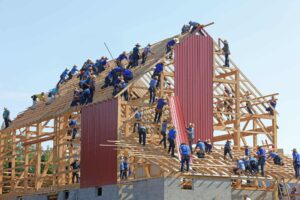Embracing Agile Team Dynamics for Transformative Success
An Agile team framework serves as a blueprint for organising the different components of a team engaged in an Agile project. These components encompass project activities, workflows, and team roles. Essentially, the structure acts as a foundational model, providing guidance to Agile teams and facilitating the arrangement of their operational procedures.
In 1965, psychologist Bruce Tuckman proposed a model delineating the stages of group development: Forming, Storming, Norming, and Performing. This adaptable framework is highly favoured by Agile project managers as it enables them to navigate their teams through diverse projects. Whenever a team member joins or departs, the team can revert back to the forming stage and embark on a fresh start. Such a level of team structure holds immense significance in scaling Agile teams.
A well-designed team structure brings about clarity, ensuring that every team member understands their respective responsibilities. With the additional layer of Agile principles, the team becomes flexible, capable of promptly and effectively responding to changes that arise.
What Makes a Great Agile Team Structure?

The Agile team structure embraces a cross-functional approach, wherein each team member possesses specific skills while collectively working towards a shared objective: delivering timely and customer-satisfying outcomes. Collaboration and open communication flourish within such cross-functional Agile teams. In fact, team members actively engage in cross-training, collaborating with their colleagues to acquire new skills and broaden their knowledge. These individuals are often referred to as T-shaped professionals, with the horizontal line representing their diverse skill set and the vertical line representing their core expertise.
Another fundamental aspect of the Agile team structure is its non-hierarchical nature. Agile teams thrive in a flat structure that empowers individuals to work autonomously and self-organise. While each team member has defined roles and responsibilities, unnecessary layers of management are eliminated, fostering effective self-management. This structure proves particularly effective in smaller groups, such as Scrum teams, where it is recommended to have three to nine members. Therefore, maintaining a level playing field within the team is both practical and beneficial.
Traditional vs Agile Team Structure
The Agile team structure stands apart from its traditional counterpart due to its absence of hierarchy. In traditional settings, a top-down approach prevails, with managers delegating tasks and dictating how they should be executed. While this structure may be suitable for larger organisations, it is not well-suited for Agile teams.
According to the Financial Times, a hierarchical structure can impede Agile teams by fostering political manoeuvring and unproductive rivalry. In contrast, an Agile environment strives to eliminate such rivalry. Agile teams generally discourage internal competition and instead unite around shared objectives.
What Are The Types of Agile Team Structure?

The selection of an Agile team structure is contingent upon several factors, encompassing cost, resource availability, and the project’s nature. It is important to note that there is no one-size-fits-all structure in Agile. Different frameworks suit different teams, each with its own set of benefits and drawbacks. Let’s explore some notable examples of Agile team structures:
Generalist Agile Teams
The generalist Agile team structure revolves around team members possessing a broad understanding of various subjects, without specialising extensively in any specific area. In essence, generalists can be described as Jacks of all trades, equipped with a range of knowledge across multiple domains.
Their adaptability allows them to engage in diverse tasks and seamlessly transition between responsibilities alongside their teammates. This Agile structure is commonly observed in smaller teams and finds particular success in the sales industry, where professionals utilise their foundational knowledge to effectively sell across different sectors within a company.
Specialist Agile Teams
Contrasting the generalist approach, a specialist embodies a team member with a distinct and specialised area of expertise. Within a specialist team structure, each individual possesses a unique niche and assumes responsibility for tasks within their domain. These highly skilled professionals are invaluable to a team, as they bring in-depth insights and knowledge to tackle complex challenges, resulting in high-quality products.
This structure is commonly found in larger Agile teams, where there are sufficient resources to cover a wide range of specific knowledge areas. Specialists can take various forms, including programmers, database administrators, product developers, and Agile practitioners, among others.
Hybrid Agile Teams
The hybrid team structure blends the strengths of both generalists and specialists. In this setup, specialists concentrate on developing intricate components of the project, while generalists connect these components to ensure the project maintains coherence as a whole. The flexibility inherent in a hybrid structure aligns with the core principles of Agile.
Moreover, it allows Agile teams to benefit from the comprehensive knowledge provided by both generalist and specialist approaches. The advantages of adopting a hybrid structure include enhanced teamwork, the production of high-quality deliverables, and a heightened sense of ownership among team members.
Parallel Agile Teams
In a parallel structure, Agile team members engage in task rotation with each new iteration. For instance, if the team collectively focuses on software development during one sprint, they will transition to software testing in the subsequent sprint.
This dynamic enables teams to deliver software in parallel, optimising productivity. However, this approach necessitates comprehensive training and a team composed of experienced members who can adeptly adapt to diverse roles. The ability to seamlessly transition between tasks is crucial for successful implementation of the parallel structure in Agile teams.
Sub-teams
The sub-team structure represents a team within a team, where individual units operate within larger Agile teams. These sub-teams focus on specific areas that combine with others to form the overall project deliverable. Employing the sub-team structure aids in breaking down large projects into manageable components, enhancing visibility and accountability throughout the process. This approach promotes collaboration and ensures that each sub-team is responsible for a distinct part of the project, contributing to its successful completion.
Transitional
Another instance of Agile team structure is the transitioning approach, which comes into play when a team adopts Agile project management methodology. This process, known as Agile transformation, involves shifting from traditional project management practices to Agile principles. To delve deeper into the intricacies of Agile transformation, we provide a more detailed exploration of the topic in a separate discussion.
Agile Team Roles

An Agile team structure typically encompasses designated roles for each team member, emphasising their skill sets rather than job titles. This defined set of roles serves to create clarity within Agile workflows. The specific roles will vary depending on the project management methodology employed by the team. In a Scrum environment, there are prescribed roles that contribute to the framework. Conversely, Kanban teams adopt a more flexible approach, with no mandatory roles.
Outlined below are some of the key roles commonly found within an Agile team structure:
Team Lead
Within an Agile team structure, a team lead assumes the crucial responsibility of coordinating and ensuring the smooth operation of processes. Their primary duties encompass organising incoming requests, managing tasks, monitoring workflows, and conducting team meetings.
Additionally, the team lead plays a vital role in upholding the principles outlined in the Agile Manifesto, fostering adherence to Agile methodologies. In Scrum specifically, the team lead is commonly referred to as a Scrum master, serving as a guide and facilitator for the team’s Agile practices.
Product Owner
In an Agile team structure, a product owner plays a pivotal role as the representative of the client. Their primary responsibility revolves around clearly defining and articulating customer requirements, ensuring their fulfilment throughout the entire Agile project life cycle.
Regular communication with the team is a key aspect of the product owner’s role, providing guidance on the inclusion of specific features and informing the team about prioritisation needs. By actively engaging with the team, the product owner ensures that the customer’s interests and expectations are effectively conveyed and incorporated into the project’s development.
Team Member
The term “team member” encompasses a wide array of roles across various industries within the context of Agile. For instance, an Agile development team consists of programmers, UX designers, software developers, and quality assurance testers.
Conversely, a digital marketing team comprises copywriters, editors, PPC managers, SEO specialists, and other professionals. In the Agile team structure, all of these individuals, regardless of their specific roles, are considered valuable team members who actively contribute to the team’s objectives. Their collective efforts ensure seamless collaboration and the successful execution of Agile projects.
Stakeholder
Stakeholders, while not directly engaged in project activities, hold a significant position in shaping the final deliverables. Collaborating closely with the team lead, product owner, and team members, stakeholders provide valuable input throughout the development process. Their feedback carries substantial weight and can profoundly impact the project’s ultimate outcome.
Examples of stakeholders encompass end-users, investors, and senior executives within the organisation. In larger Agile team structures, additional roles such as independent testers, enterprise architects, system integrators, and subject matter experts may also contribute their expertise to ensure the project’s success. The involvement of stakeholders ensures that diverse perspectives are considered, leading to well-informed decision-making and delivering outcomes that align with organisational goals.
How Can I Build An Agile Team Structure?

Embarking on the development of your Agile team structure but unsure where to begin? Follow these steps to set a solid foundation:
- Choose Your Model: Evaluate your project requirements and consider the suitability of different team structures. Determine whether a team of generalists or specialists would be more beneficial. Assess the feasibility of a hybrid structure, leveraging both expertise types. Additionally, explore the possibility of breaking down your project into sub-teams for enhanced focus and efficiency.
- Assign Roles: Conduct a thorough assessment of the skills and capabilities of your Agile team members. Ensure that each individual is assigned a role that aligns with their strengths and expertise. This step guarantees that team members can effectively contribute and fulfil their assigned responsibilities.
- Stay Adaptable: Remember that Agile team structures are designed to be flexible and adaptable. Embrace a culture of listening and learning from your team. Regularly assess the effectiveness of your chosen structure and be open to making adjustments when necessary. This adaptability ensures that your team structure remains in sync with evolving project needs.
By following these steps, you can establish a robust Agile team structure that aligns with your project requirements and maximises your team’s potential for success.
How Does Agile Aid Team Collaboration?
Agile project management offers various approaches to collaboration, depending on the specific Agile framework adopted. For instance, the Scrum framework organises small teams called scrums, led by a scrum master. The scrum master’s primary role is to remove obstacles and ensure the scrum has the necessary resources to complete their work. The Scrum framework operates through short iterations called sprints, encompassing planning, demos, retrospectives, and daily meetings where the team discusses progress, challenges, and priorities.
Another prevalent Agile framework is Kanban, which employs a visual approach to project management. Teams create physical representations of tasks, often using online apps or traditional sticky notes on whiteboards. Tasks move through predetermined stages, allowing the team to track progress and identify obstacles. The visual nature of Kanban enables team members to have real-time visibility into the project’s status, promoting seamless task transitions.
While Agile frameworks provide specific collaboration methods, the fundamental principles of team building remain essential regardless of the framework chosen. Consider the following 2 tips for effective cross-functional Agile team collaboration:
- Dedicate Time to Team Building: Foster rapport among project team members to establish trust, break down barriers, and enhance communication. Encourage feedback from everyone, ensuring that even introverted team members have an opportunity to contribute their valuable ideas. Adapt communication styles to accommodate individual preferences and ensure that all voices are heard.
- Utilize Suitable Collaboration Tools: Employ software tools specifically designed to meet the needs of Agile teams. These tools facilitate effective sharing and collaboration, enabling teams to fully leverage the benefits of Agile project management.
By implementing these strategies, your Agile team can enhance collaboration, build strong relationships, and leverage the power of Agile methodologies to achieve project success.
How To Keep Remote Agile Teams On Track

Recognizing the significance of collaboration for project success, an adept Agile manager places great emphasis on facilitating effective collaboration, particularly for remote teams. Collaborative efforts enhance communication and overall productivity within projects. To promote collaboration, consider organising brainstorming sessions and engaging in team-building activities that reinforce a sense of unity, accountability, and cohesion among remote team members.
Furthermore, implementing daily standups can enhance accountability and progress tracking. These brief meetings allow team members to share their completed tasks from the past 24 hours, outline forthcoming goals for the next 24 hours, and address any anticipated challenges. Leveraging communication and remote collaboration tools, such as video conferencing services and chat platforms, enables efficient monitoring of progress while avoiding unnecessary micromanagement.
Additionally, utilising project management software empowers teams to stay on target by employing features like to-do lists, automated task reminders and notifications, interactive Gantt charts, real-time dashboards, and more. With a diverse range of options available, team members can leverage their preferred tools to stay focused and contribute to project success.
Remote Team Management Tips
Promoting project agility involves enabling your team to swiftly adapt to changes and fostering a culture of continuous improvement. Here are seven remote team management tips to promote Agile practices while working from home:
- Facilitate Communication: Focus on facilitating effective communication channels between your team and other stakeholders. Remove roadblocks that hinder progress and ensure regular check-ins to address any needs or concerns. Remote workers may feel isolated, so fostering communication is vital.
- Play to Team Strengths: Recognize how your team works and collaborates best, then prioritise their strengths. Grant them the freedom to think outside the box, which boosts productivity and encourages innovation.
- Flexible Work Approaches: Allow team members to work in their preferred style as long as deadlines are met. Set recurring meetings and establish critical hours when work schedules overlap. Utilize those shared hours for collaborative activities, team meetings, reviews, feedback, and other tasks requiring collective input, while reserving quieter hours for individual tasks.
- Encourage Asynchronous Communication: Support work-life balance by communicating that immediate responses are not always necessary. Encourage employees to disconnect after work hours, helping them recharge and be more productive the following day.
- Implement Collaboration Tools: Adopt tools, processes, and practices that enhance visibility and enable continuous collaboration and communication, even in remote settings. Look for project management solutions with in-app messaging and task dependencies to keep remote teams aligned regardless of their geographical locations.
- Leverage Automation: Streamline and automate routine tasks for remote employees. Implement automation for project notifications and updates to save time and ensure everyone stays informed.
- Embrace Retrospectives: Emphasize the agile mindset by conducting retrospectives at the end of each sprint or project phase. Collaborate with your team to review successes, areas for improvement, and identify actionable steps to enhance future performance.
By implementing these tips, you can effectively manage remote teams, promote Agile practices, and drive continuous improvement while working from home.
FAQ
What Are The 5 Stages of An Agile Team
Navigating Team Development: Tuckman’s Framework for Agile/Scrum and Beyond
Bruce Tuckman’s renowned framework sheds light on the stages of development that Agile/Scrum and other teams typically experience. Tuckman identified a sequence of crucial phases, namely Forming, Storming, Norming, Performing, and Adjourning. These stages are integral to the team’s growth, enabling them to address challenges, seek resolutions, establish effective work plans, and ultimately deliver desired outcomes. Embracing Tuckman’s framework empowers teams to navigate their developmental journey, foster collaboration, and achieve success in their endeavours.
Forming
Unveiling the Forming Phase: Characteristics and Strategies
The Forming phase is marked by distinct characteristics that shape the initial dynamics of a team. During this stage, team members engage in questioning, socialising, displaying enthusiasm, focusing on group identity and purpose, and sticking to safe topics. To effectively navigate the Forming phase, consider employing strategies such as taking the lead, providing clear expectations and consistent instructions, and maintaining prompt response times. These approaches help establish a solid foundation for the team, fostering a sense of direction and enabling efficient progress as they embark on their collaborative journey.
Storming
Navigating the Storming Phase: Traits and Strategies
The Storming phase is characterised by various traits, including resistance, lack of participation, conflict, competition, heightened emotions, and the gradual establishment of group norms. To effectively navigate this stage, it is essential to employ strategies that normalise the situation and encourage leadership. By acknowledging and addressing the challenges that arise during the Storming phase, teams can foster open communication, promote active participation, and channel conflicts towards constructive resolutions. Encouraging emerging leaders within the team can also contribute to establishing a cohesive and productive working environment. These strategies aid in navigating the Storming phase and pave the way for the team to progress towards enhanced collaboration and effectiveness.
Norming
Embracing the Norming Phase: Features and Strategies
The Norming phase is characterised by notable features, including reconciliation, relief, decreased anxiety, active engagement, support among team members, and the development of group cohesion. To leverage the potential of this phase, employing effective strategies is crucial. Recognizing individual and group efforts fosters a positive and inclusive environment. Providing learning opportunities and constructive feedback enables continuous growth and improvement. It is also essential to monitor the energy and dynamics of the group, ensuring that the collective enthusiasm and collaboration remain strong. By implementing these strategies during the Norming phase, teams can enhance their cohesiveness, sustain motivation, and further progress towards achieving shared goals.
Performing
Thriving in the Performing Phase: Characteristics and Strategies
The Performing phase is characterised by distinct traits that indicate a high-functioning team. These traits include the demonstration of interdependence, a healthy and cohesive system, the ability to effectively produce as a team, and a balance between task and process orientation. To leverage the potential of this phase, implementing effective strategies is key.
Celebrating achievements and milestones fosters a positive team culture and reinforces motivation. Adopting a “guide from the side” approach, with minimal intervention, empowers team members to take ownership and make autonomous decisions. Encouraging group decision-making and problem-solving cultivates a sense of collaboration and collective responsibility. Providing opportunities for sharing learning across teams enhances knowledge exchange and continuous improvement.
By applying these strategies during the Performing phase, teams can sustain their high performance, optimise productivity, and create a harmonious environment where individuals thrive collectively.
Adjourning
Transitioning in the Adjourning Phase: Traits and Strategies
The Adjourning phase is characterised by specific traits that mark the conclusion of a team’s journey. During this phase, there is a shift towards process orientation, accompanied by feelings of sadness and reflexion on team and individual accomplishments. To navigate this phase effectively, it is essential to implement strategies that acknowledge and support the process of change.
Recognizing the significance of the transition, both for the team and its members, helps create an atmosphere of acceptance. Providing an opportunity for summative team evaluations allows for reflexion on the team’s achievements, challenges, and lessons learned. Additionally, creating a platform for acknowledgments and expressing gratitude enables team members to celebrate individual contributions and express their appreciation for one another.
By implementing these strategies during the Adjourning phase, teams can foster closure, embrace the process of transition, and leave with a sense of accomplishment and camaraderie.
What Is The Rule Of 3 In Agile?
The Three-Tiered Rule for Goal Setting: Daily, Weekly, and Yearly Focus
A simple rule to guide your goal-setting process involves three key steps. Firstly, jot down three things you aim to accomplish today, focusing on immediate tasks and objectives. Secondly, outline three goals you aim to achieve within the week, encompassing broader milestones and targets. Lastly, identify three significant aspirations you strive to accomplish over the course of the year, emphasising long-term achievements and ambitions. This three-tiered approach provides a structured framework to align your daily, weekly, and yearly goals, empowering you to effectively plan and prioritise your actions for optimal productivity and progress.
What is 3-5-3 In Agile?
Simplifying the Agile Structure: Roles, Events, and Artifacts
In its essence, the Agile structure revolves around three fundamental roles: the Product Owner, the Scrum Master, and the Team. These roles form the core of Agile teamwork and collaboration.
The Agile framework comprises five key events that drive the iterative development process: Sprint, Sprint Planning, Daily Scrum, Sprint Review, and Sprint Retrospective. These events provide essential touchpoints for planning, coordination, and reflection throughout the Agile project lifecycle.
To support effective collaboration and progress tracking, Agile teams rely on three essential artefacts: the Product Backlog, the Sprint Backlog, and the Increment. These artefacts serve as valuable tools for prioritising and organising work, documenting progress, and ensuring the delivery of a tangible product increment.
By embracing this simplified Agile structure, teams can streamline their workflows, enhance communication, and effectively deliver valuable outcomes in a dynamic and iterative manner.
Overview
Adopting a dynamic team structure and embracing agility can propel your organization to new heights of success. By promoting collaboration, adaptability, and innovation, you empower your team to navigate challenges, seize opportunities, and deliver exceptional results. Embracing agility not only enhances productivity and efficiency but also fosters a culture of continuous improvement and learning. So, reimagine your team’s structure, harness the power of agility, and unlock a future filled with growth, resilience, and remarkable achievements.
Now that you’ve got your team nailed down, check out our guide to agile portfolio management and see how you can reduce customer churn with our tips on closing your customer feedback loop.
If you’ve enjoyed this post, we’d recommend diving into the following other posts in this Agile series:
- An Introduction to The Agile Methodology
- Themes, Epics and User Stories – The Core Components Of Agile
- Embracing Agile Team Dynamics
- What is SAFe Agile and Why Should I Use It?
- What is Waterfall Development?
- What is Lean Development?
- What is Scrum?
- A Deep Dive Into Epics
- Exploring The Power of User Stories
- How Can I Use Personas?
- Decoding Agile Estimation (Story Pointing)
- Agile Transformation: How Can My Business Start Using Agile?
- The Spotify Approach To Agile Development
- What Is Agile Portfolio Management?
- Agile Glossary
- Agile Statistics







